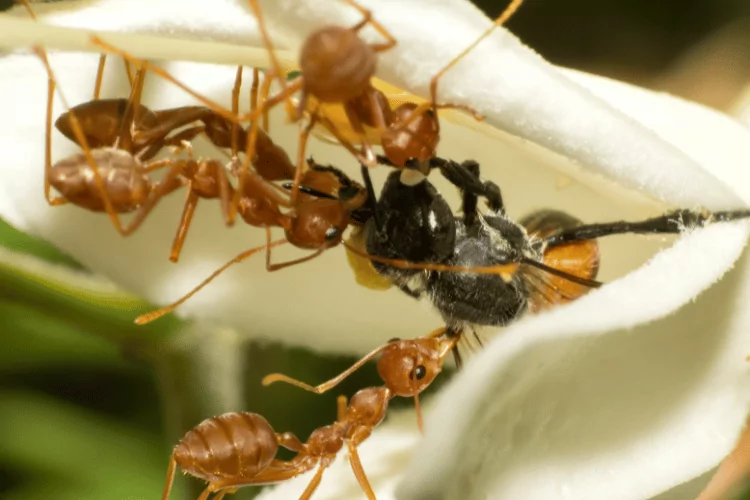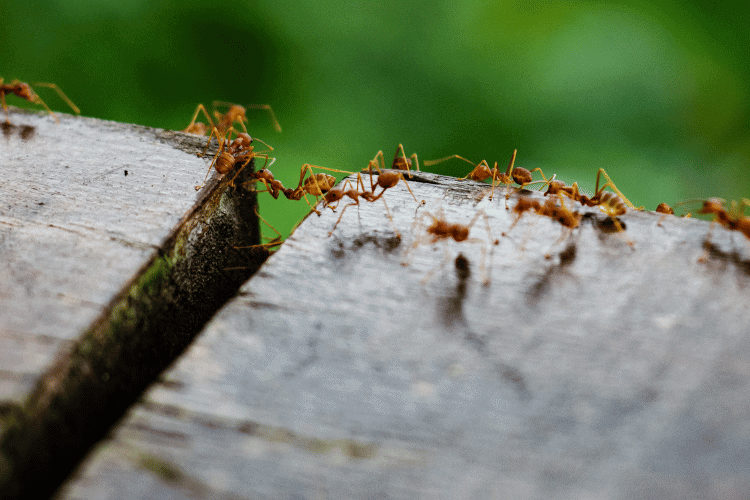Beekeeping comes with its share of challenges. One of these difficulties is dealing with beehive ant infestations while ensuring the safety of your bees.
“So, how do I get rid of ants without harming bees?”
It’s easier than it seems, and there are quite a few bee-friendly solutions that you can resort to when faced with an ant infestation, with some being more practical than others.
With that in mind, this guide highlights practical, eco-friendly methods to keep ants away while maintaining a thriving beehive.
Let’s dive in!
What Attracts Ants to Bee Hives?
As you probably know, ants have a sweet tooth. That’s why a beehive laden with honey is a particularly enticing destination for them. The aroma of honey can act as a beacon, drawing ants towards the hive in search of a sugary feast.
Additionally, the sugar water you might place in bee feeders becomes another irresistible temptation for these insects.
Are Ants Harmful to Bees?

Spotting ants in a few numbers in your beehive is normal. However, large-scale ant invasions can pose a significant threat to honey bee colonies.
Ants invade beehives, causing damage and weakening the bee colony. They’re also resourceful thieves, stealing valuable resources from the hive and engaging in skirmishes with bees.
Even worse, large-scale ant invasions may even force honey bee colonies to abandon their hives.
Given that, ant invasions serve as a red flag for beekeepers, signaling potential weaknesses within the hive.
While strong bee colonies can often fend off ants independently, smaller, weaker colonies may require your assistance.
What to Do With the Invasive Ants on the Beehive
If ants have already invaded your beehive, scraping as many of them as possible away using a manual tool is your first step to addressing the problem.
Then, you need to identify their access point and disrupt it using a bee-friendly ant deterrent substance such as cinnamon.
More importantly, to prevent further invasions, you’ll need to take a bunch of preventive measures. This is the discussion of the next section.
How Do You Prevent Ants From Invading a Beehive?

When eliminating ants from your beehive, using chemicals is obviously the worst option, as they also harm the bees.
However, there are natural ways you can use to prevent ants from invading your beehive and interrupt the current invasion.
That said, you shouldn’t use any of these solutions inside the beehive; all of them should be applied around it.
The following are the eight most recommended solutions:
1. Use a Hive Stand
Elevating your beehive above ground level is crucial in ant-prone areas. As such, a hive stand is a strategic defense against ant invasions. It creates a physical barrier, distancing the hive from ants and discouraging their ascent.
Some stands even feature built-in moats on the legs, forming an additional line of defense against these intruders.
2. Create a Soapy or Vegetable Oil Barrier
To further fortify the stand’s defense line, build moats around its legs. This method involves placing wide containers around hive stand legs, creating an ant-deterring moat. Ants can’t reach the hive without navigating the moat.
Use soapy water or vegetable oil, preferably olive oil or canola oil, in the moat to prevent ants from circumventing the barrier.
Alternatively, some beekeepers apply Diatomaceous Earth powder around the legs of the stand. This simple yet effective solution provides an added layer of protection against ant invasions.
3. Fix Holes and Cracks in the Hive
Ants find their way into beehives through small openings in the wood. So, you need to regularly inspect all hive boxes for potential entry points.
Addressing cracks and holes promptly prevents unwanted ant invasions.
4. Clean Your Apiary Properly
Maintaining a clean apiary is crucial to prevent ant invasions. Discarded burr comb on the ground can attract ants.
That way, make sure to remove burr comb and debris during inspections using a small bag or bucket.
5. Surround the Hive with Ant-Repelling Plants
Combat ant invasions naturally by planting ant-repelling flora around your hive. Peppermint, lavender, rosemary, and citronella are excellent choices.
These plants emit scents that ants detest. So, they minimize the hassle of dealing with ant colonies near your hives.
This eco-friendly approach not only acts as a natural deterrent but also adds a touch of greenery to your beekeeping space.
Speaking of plants, check out this guide on the best plants for honey bees to learn about your bees’ favorites.
6. Use Motor Oil
An alternative to moats, this method involves coating hive stand legs with inexpensive motor oil. To apply this method, evenly spread oil on the bottom of the stand’s legs to thwart ant climbing attempts.
This low-cost solution is a reliable barrier, preventing ants from finding their way to your hives. That said, to maintain the oil’s effectiveness, you’ll need to apply a new oil layer periodically.
7. Sprinkle Cinnamon Around the Beehive

For unknown reasons, sprinkling ground cinnamon around your beehive’s stand legs deters ants without affecting your bees. Make sure to sprinkle some cinnamon on ant trails as well.
Ground cinnamon proves challenging for ants to navigate, making it a simple yet powerful addition to your ant defense toolkit.
8. Coat the Hive Stand Legs Using Tanglefoot
Tanglefoot Tangle-Trap Sticky Coating offers an effective solution to your ant invasion problem. This natural product provides a sticky barrier when applied directly to hive stand legs. It is a reliable defense, preventing ants from climbing and infiltrating your beehive.
Still, you should apply it closer to the ground to minimize the risk of catching bees instead of ants. You also need to reapply it every month or two to maintain effectiveness.
9. Remove Thick Bushes and Undergrowth
Ant invasions can occur through tall weeds and wild grasses that create an ant path to your hive. Eliminate this risk by removing thick bushes and undergrowth around your hive. This method, combined with others such as moats, enhances overall ant control.
In addition, consider covering the area beneath and around the hive with gravel to prevent undergrowth.
Wrapping Up
By now, you know the answer to the question: How do I get rid of ants without harming bees?
With eco-friendly strategies like moats, cinnamon barriers, and ant-repelling plants, you can combat ant invasions without causing harm to your bees.
Remember that physically removing ants with a proper tool is the only safe solution if they have already invaded the beehive.
- Does Bleach Kill Bees? - April 23, 2024
- How Do I Get Rid of Ants Without Harming Bees? - April 16, 2024
- Do Bug Zappers Kill Bees? Completely Explained - April 9, 2024
